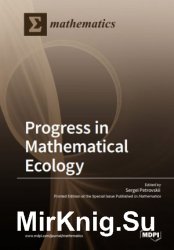
Название: Progress in Mathematical Ecology
Автор: Sergei Petrovskii
Издательство: MDPI
Год: 2018
Формат: pdf
Страниц: 216
Размер: 17,8 mb
Язык: English
Mathematical modelling plays a special role in ecology. Although traditional ecology is a largely empirical science, replicated experiments are not often possible because of the high complexity of ecological interactions and the impossibility to reproduce the weather conditions. Moreover, large-scale field experiments (where the consequences are usually not fully known) can be damaging for the ecological communities and costly or even dangerous for humans. Mathematical modelling provides an efficient supplement and sometimes even a substitute to an empirical study; it creates a virtual laboratory where different hypotheses can be tested safely, and at relatively low cost.
Application of mathematics to problems arising in ecology and population dynamics—to which we broadly refer as mathematical ecology—has a long and glorious history. It was mutually beneficial for both of the disciplines involved and there are many examples of that. Prey–predator population cycles are one of the core concepts of contemporary ecological theory, but the route of this idea goes back to the works of Vito Volterra. Food web analysis is a fruitful and fast developing area of ecology, but its progress would hardly be the same without the insights and tools from the mathematical theory of networks. Ecological research on the spatial spread of traits and species was the starting point for the mathematical theory of diffusion-reaction waves, and Alan Turing’s study on morphogenesis led to the development of the theory of self-organized pattern formation.